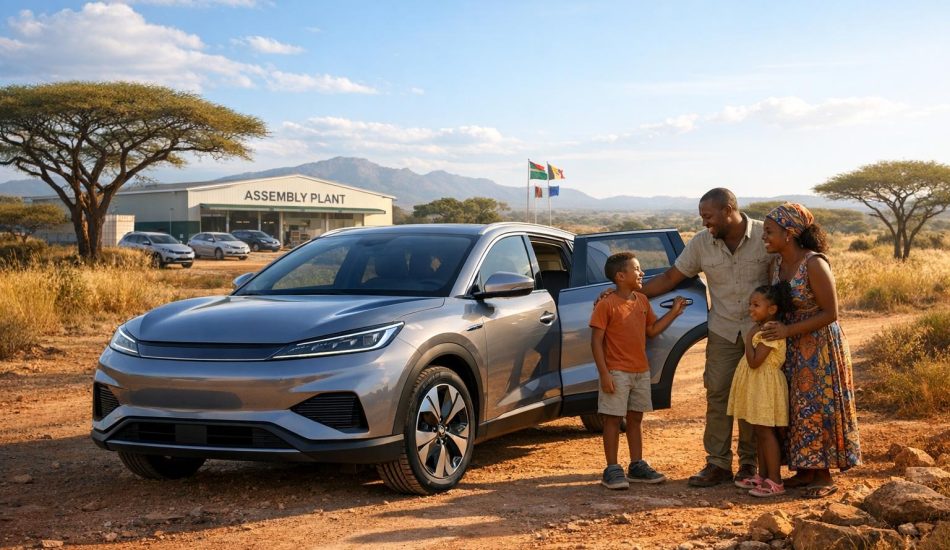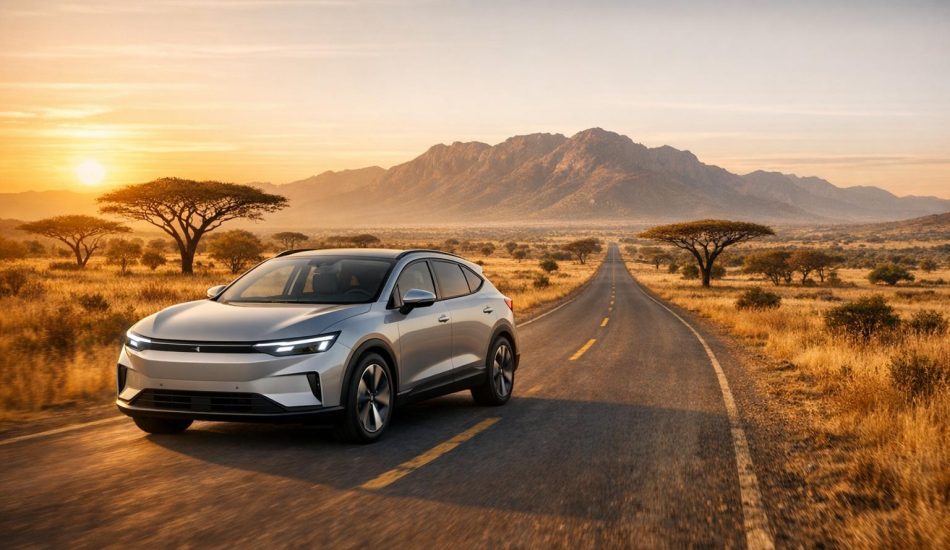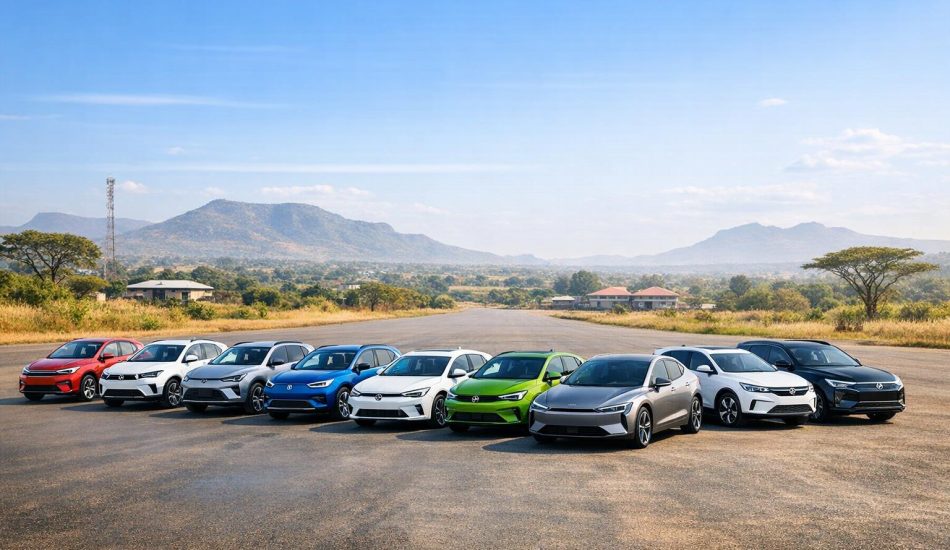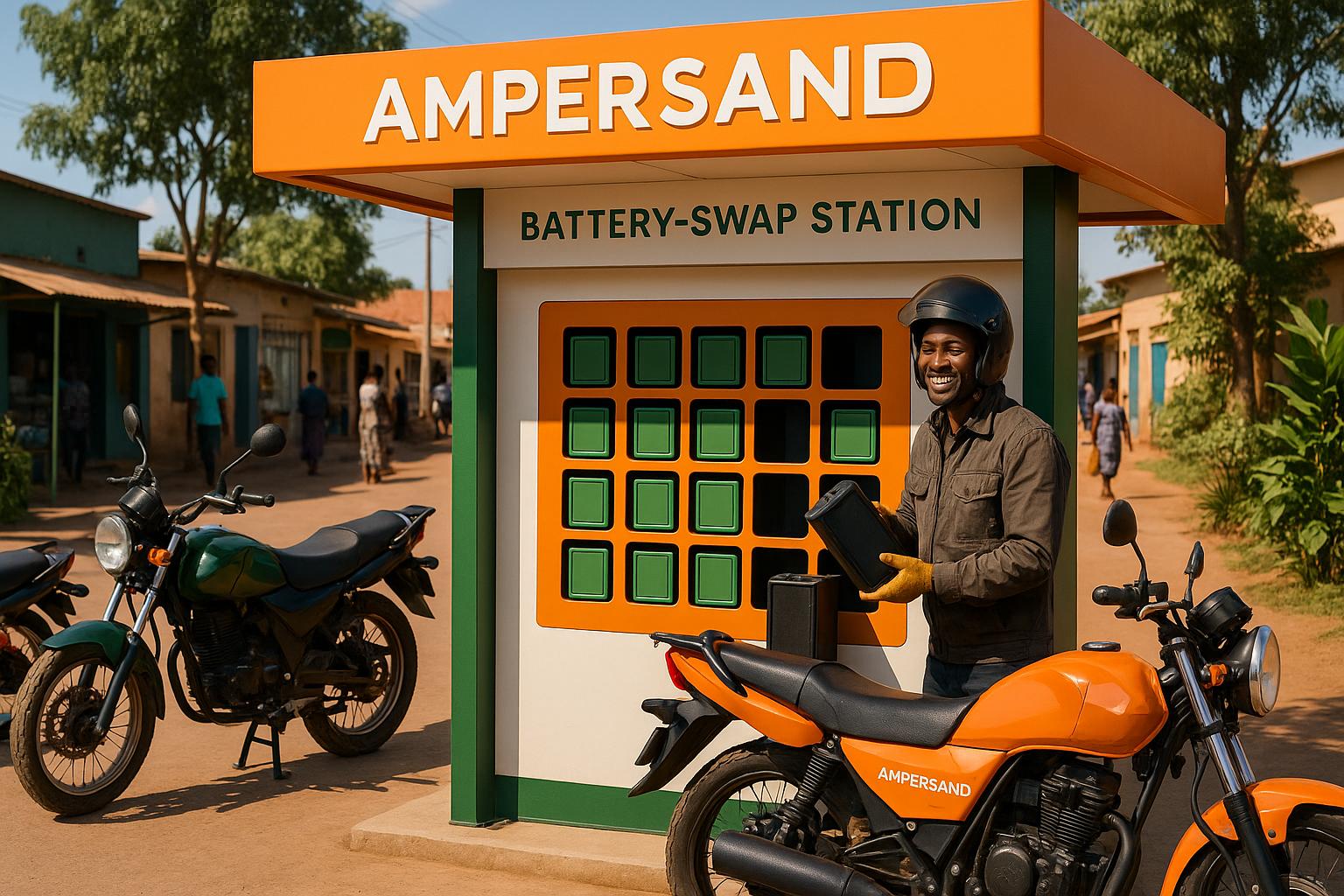
Ampersand is transforming motorcycle transportation in Rwanda and Kenya by expanding its electric motorcycle (e-moto) and battery-swap station network. Founded in 2016, the company’s approach simplifies EV adoption with quick battery swaps, cutting downtime for riders while reducing costs and emissions. Here’s what you need to know:
- Scale: Over 5,800 e-motos currently operate in Rwanda and Kenya, covering 950,000 kilometers daily.
- Impact: The fleet has prevented 12,000+ tons of CO₂ emissions and offers riders 45% higher earnings compared to gas-powered bikes.
- Battery-Swap Stations: 18,000+ swaps are conducted daily, with stations designed for speed and ease – swaps take under two minutes.
- Future Goals: By 2030, Ampersand aims to support 1 million vehicles with its network and deploy 600,000 e-motos.
- Renewable Energy: Solar-powered stations are being integrated, further reducing emissions and reliance on unreliable grids.
Ampersand’s model not only addresses affordability and infrastructure challenges but also supports cleaner cities and higher incomes for drivers.
How BATTERIES Are Charged In JUST TWO (2) Minutes In KENYA | Electric Boda
Ampersand Battery-Swap Station Operations
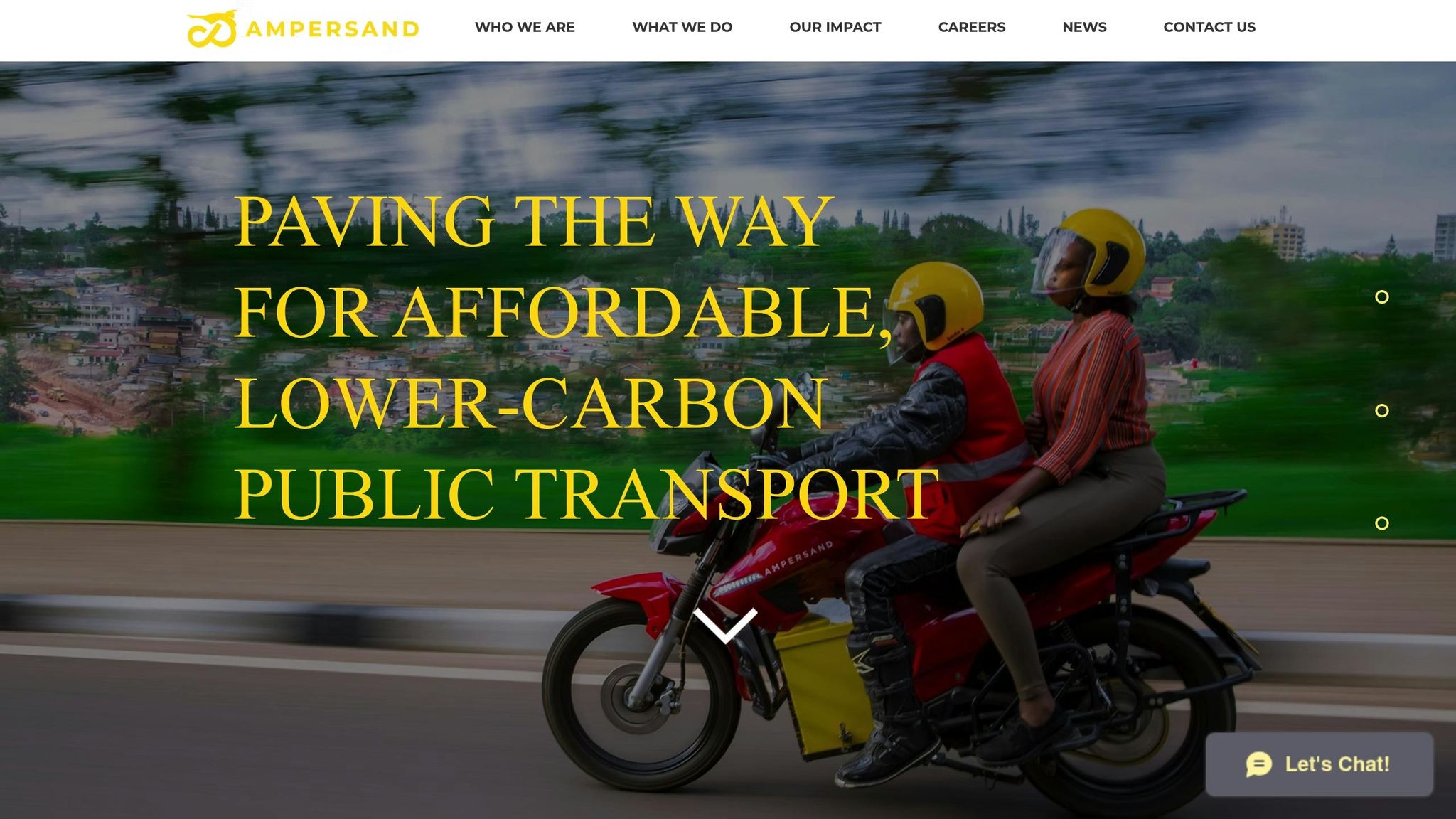
Ampersand’s battery-swap stations tackle the infrastructure hurdles that have slowed electric vehicle adoption in East Africa. These stations are the backbone of Ampersand’s e-mobility network, managing nearly 18,000 battery swaps and recharges daily across Rwanda and Kenya. This level of efficiency is a key part of Ampersand’s broader mission to transform transportation in the region.
The focus is on speed and convenience. Riders can swap out a depleted battery for a fully charged one in less than two minutes, ensuring that e-moto taxi drivers spend more time earning on the road instead of waiting.
Station Design and Setup
Ampersand’s battery-swap stations are designed for flexibility and rapid deployment, making them accessible in both urban and rural settings. Strategically placed along high-traffic routes and common travel corridors, these stations ensure e-motorcycle riders can easily find and access them.
Each station is equipped with multiple charging units to handle a steady flow of battery swaps. For example, a pilot project in Nairobi in September 2024 demonstrated the scale of these setups, featuring 36 charging units and 150 lithium-ion batteries on-site. This ensures that riders always have access to charged batteries, even during busy periods.
The stations require minimal infrastructure, allowing Ampersand to expand into new areas quickly without being bogged down by lengthy construction or permitting processes.
"We have created a network of swap stations that allow drivers to access smart batteries as and when they need them." – Ampersand Energy
How the Battery-Swap Process Works
Ampersand has streamlined the battery-swap process to keep things fast and efficient. Riders use the Ampersand Driver App to track their battery levels and locate the nearest swap station. This seamless digital integration makes the system more user-friendly and effective.
At the station, a technician handles the swap. For instance, in Kigali, e-moto taxi rider Numukobwa Dative uses the Ampersand app to monitor her battery life. When it’s time for a swap, a technician uses a locally made trolley to remove the drained battery and replace it with a fully charged one.
The swap itself takes less than two minutes. Including steps like digital check-in, technician assistance, and payment, the entire process usually takes under five minutes and costs about $1.60 per swap. This pay-per-use pricing model is economical, offering riders savings of roughly 45% compared to traditional fuel and oil costs. Payments are processed digitally, and riders are charged only for the energy they use during each swap.
Solar Power Integration
Ampersand is also integrating solar power into its operations to make them more sustainable. In a September 2024 pilot project in Nairobi, Ampersand partnered with CrossBoundary Energy to power its battery-swap stations with renewable energy.
This pilot features a 37kWp solar PV system that charges the station’s 150 lithium-ion batteries. By using solar energy, Ampersand reduces its carbon footprint and gains independence from unreliable grid connections – an especially valuable feature in rural and remote areas.
Hezbon Mose, Kenya Country Director at Ampersand, highlighted the importance of this initiative:
"The availability of reliable, affordable charging infrastructure is essential to scaling our operations and meeting the growing demand for e-mobility in Kenya. With CrossBoundary Energy’s solution, we are confident we can expand faster and more efficiently, bringing our e-bikes to more riders across Kenya and East Africa. By leveraging solar power this expansion will be even more sustainable, cutting carbon emissions faster."
This approach also helps lower operational costs by reducing dependence on fluctuating fuel prices and grid electricity rates. In Kenya, where over 70% of electricity is generated from clean sources like geothermal, solar, and wind, this strategy aligns perfectly with the country’s energy landscape.
Under the partnership, Ampersand purchases renewable electricity from CrossBoundary Energy while continuing to manage battery maintenance and station operations. Additionally, Ampersand uses real-time battery data to optimize station performance, ensuring that charged batteries are distributed efficiently throughout its network.
Effects on Riders, Communities, and Environment
Ampersand’s battery-swap network is doing more than just changing how people get from point A to point B. It’s reshaping lives, boosting local economies, and making a noticeable difference in environmental health across Rwanda and Kenya.
Rider Benefits
For e-moto riders, the financial perks are immediate and impactful. Riders are seeing a 45% increase in earnings, thanks to lower fuel and maintenance costs. This translates into more take-home income and less financial strain.
Josh Whale, Ampersand’s CEO, explains the numbers:
"For a motorcycle driver with a petrol bike, the energy costs are around $2,000 a year. With us, that cost is reduced by about a third. So, every year, our drivers are saving about $700."
Take Numukobwa Dative, an e-moto taxi rider in Kigali, as an example. She bought her e-motorcycle for $2,100 through financing and now earns up to $23 daily – a 35% bump in her weekly income compared to when she used a petrol bike. The benefits go beyond just savings. Ampersand takes care of all battery maintenance, cutting down on repair costs and downtime for riders. Plus, the efficient batteries allow them to work longer hours without worrying about running out of range.
Job Creation and Economic Impact
The economic ripple effects don’t stop with the riders. Ampersand’s growth is creating jobs across various sectors. With over 300 employees, the company assembles 100 e-motorcycles and 140 batteries every week. These roles span everything from battery assembly and motorcycle building to software testing and research.
Ampersand is also breaking barriers with inclusive hiring. Over 60 women are part of their driver network. Lydia Micomyoza, a lead technician at Ampersand, sums it up well:
"As the company grows, we also grow."
Kenya’s President William Ruto has also highlighted the broader economic benefits:
"It creates jobs and transfers knowledge, technology and skills to our market in a very sustainable way."
The company’s impact extends to the entire transportation ecosystem. Ampersand supports over 1.2 million kilometers (roughly 745,000 miles) of travel per week and facilitates 120,000 battery swaps every month across Rwanda and Kenya. This activity supports local businesses, from technicians managing the swaps to vendors and services in the communities where riders operate.
Solar-powered battery swap stations add another layer of economic benefit. By selling green electricity to station operators, these stations not only support the e-mobility infrastructure but also promote energy independence within local communities.
Environmental Results
Ampersand’s model isn’t just about economics – it’s also about creating cleaner, healthier cities. Each e-motorcycle eliminates about two tons of CO₂ emissions annually, directly addressing urban air pollution.
To put it in perspective, gasoline motorcycles emit around 11.78 kilograms (about 26 pounds) of CO₂ per 100 kilometers. In contrast, electric motorcycles powered by renewable energy slash emissions by 98% compared to their gas-powered counterparts. Even in areas where electricity grids rely on fossil fuels, e-motos still generate 75% fewer lifecycle emissions than traditional motorcycles.
In Rwanda, where road transport accounts for 13% of national emissions and gas-powered motorcycles contribute over 90% of particulate air pollution, the shift to electric vehicles is transformative. By May 2019, Ampersand’s fleet of 35 e-motorcycles and batteries had already clocked over 1.3 million kilometers (about 810,000 miles) on Kigali’s streets, cutting CO₂ emissions by 75–95% while producing zero tailpipe emissions.
Alice Rwema, Ampersand’s General Counsel, underscores the immediate impact:
"Our motorbikes are quiet, which reduces significant noise on the street. In addition, our drivers get to breathe cleaner air. That’s very important to us."
Beyond emissions, e-mobility reduces dependence on imported refined petrol, helping preserve foreign exchange reserves. In Nairobi, where traffic emissions contribute 20% of the city’s greenhouse gas emissions and 40% of its air pollution, electric motorcycles offer a clear path to cleaner, healthier urban environments.
The integration of solar energy at battery-swap stations amplifies these benefits. These stations operate independently of fossil-fuel grids, creating a self-sustaining transportation system that improves air quality and aligns with global climate goals. This approach not only enhances community health but also reinforces Ampersand’s mission to transform urban mobility for the better.
sbb-itb-99e19e3
Ampersand’s Growth and Future Plans
Ampersand has evolved from a startup into East Africa’s leading name in e-mobility, with operations that reflect its ambitious growth plans. The company’s achievements have paved the way for key partnerships and a well-defined strategy for regional expansion.
Current Operations Scale
Ampersand currently manages an impressive fleet of over 4,000 electric motorcycles in Rwanda and more than 1,300 in Kenya, bringing the total to over 5,700 e-motorcycles across these two markets. Supporting this fleet is an infrastructure of 25 battery-swap stations strategically placed throughout Kenya and Rwanda. These stations are critical for the company’s commercial fleet, which operates in Kigali and Nairobi, covering about 3,000,000 kilometers (1,864,000 miles) each week and facilitating roughly 75,000 battery swaps weekly.
Reflecting on this milestone, Alp Tilev, co-founder and CTO of Ampersand, shared:
"Our team is incredibly proud of this achievement. Our e-motos have been embraced by the community as a reliable, climate friendly and cost-effective mode of transportation."
Business Partnerships
Ampersand’s growth has been fueled by strategic collaborations. In December 2023, the company joined forces with TotalEnergies to install battery-swap stations at 16 additional TotalEnergies service stations in Nairobi. This move ensures that battery exchange facilities are conveniently located within 5 to 10 kilometers of operational areas, offering a user experience that rivals traditional gas stations.
In September 2024, Ampersand partnered with CrossBoundary Energy to introduce solar-powered charging infrastructure at its swap stations. Under this arrangement, CrossBoundary Energy owns and finances the charging units and batteries, while Ampersand pays for the energy it uses. The pilot project includes 36 electric charging units and 150 lithium-ion batteries powered by a 37kWp solar PV system.
"With CrossBoundary Energy’s solution, we are confident we can expand faster and more efficiently, bringing our e-bikes to more riders across Kenya and East Africa. By leveraging solar power this expansion will be even more sustainable, cutting carbon emissions faster."
Additionally, partnerships with financial institutions like Jali Finance, Bboxx, M-Kopa, and Watu allow customers to finance their e-bikes over a 24-month period. These collaborations are instrumental in supporting Ampersand’s current operations and its ambitious growth plans.
Expansion Goals
Ampersand has set its sights on deploying 5 million electric motorcycles by 2033. By 2030, the company aims to have over 600,000 electric motorcycles in operation across East Africa and plans to support 1,000,000 vehicles with battery swaps at its charging stations – a massive 100-fold increase from its current scale.
Geographic expansion is also a key focus, with plans to enter Tanzania, Uganda, and other regional markets. A partnership with Chinese EV manufacturer BYD will play a crucial role in this effort, with plans to produce 40,000 electric motorcycles in Rwanda and Kenya by the end of 2026. Ampersand is also opening its energy infrastructure to other motorcycle manufacturers, further broadening its impact.
Josh Whale, Ampersand’s CEO, emphasized:
"This additional investment will accelerate the rollout of our EV energy technology and infrastructure to the mass market, bringing us closer to our goal of deploying 5 million electric motorcycles by 2033."
"By integrating multiple brands into our battery network, we are building a system that benefits more riders, creates affordability, and accelerates clean mobility adoption at scale."
Through these strategic initiatives, Ampersand is not just reshaping the e-mobility landscape in East Africa but also positioning itself as a key energy infrastructure provider, driving the region’s shift toward sustainable electric transportation.
E-Moto Adoption Considerations
Switching to electric motorcycles is a decision that balances operational advantages with the unique infrastructure and cost requirements of traditional gasoline motorcycles. For riders and fleet operators, these practical considerations align with Ampersand’s broader mission to enhance urban mobility in a sustainable way.
Battery-Swap vs. Standard Charging
One of the most critical decisions for e-moto users is choosing between battery swapping and standard charging. Battery swapping offers a faster and more convenient solution compared to traditional charging methods. For example, swapping a battery takes just 88 seconds, while a full charge can take anywhere from 2 to 6 hours. This speed is a game-changer for commercial motorcycle taxi riders who need to minimize downtime and maximize their working hours.
| Aspect | Battery-Swap | Standard Charging |
|---|---|---|
| Speed | 88 seconds to 2 minutes | 2–6 hours for a full charge |
| Convenience | Fully charged batteries readily available | Requires waiting for charging completion |
| Infrastructure Cost | Higher upfront investment for specialized stations | Lower cost using existing electrical setups |
| Battery Life | Extended lifespan through managed, slow charging | Risk of degradation from fast charging |
| Operational Flexibility | Allows continuous operation | Requires significant downtime |
Battery swapping clearly stands out for high-demand urban routes, as it eliminates range anxiety and reduces downtime. For instance, Ampersand riders in Rwanda average 3.7 swaps per day, covering about 124 miles (200 km) daily in Kigali. In Kenya, riders typically perform 2 swaps per day, traveling around 93 miles (150 km) in Nairobi. Additionally, Ampersand’s pay-as-you-go system for batteries removes the need for upfront battery purchases, lowering initial costs.
Rider Cost Breakdown
Ampersand’s battery-swap system not only reduces downtime but also improves daily earnings for motorcycle taxi operators. With a market price of $1,600 for an Ampersand e-moto, the cost aligns with traditional gasoline motorcycles but delivers significant operational savings.
Daily expenses highlight this difference. Gasoline motorcycle riders spend about $5.50 per day on fuel, while Ampersand e-moto riders cut this down to $2.70. Over a year, this translates to fuel savings of $650–$700, boosting daily income by approximately 45% compared to petrol-powered bikes. These savings can nearly double net daily earnings by reducing operating costs.
Battery rentals through Ampersand further reduce expenses, offering about 45% savings compared to fuel and oil changes. Each battery provides a lifespan of around 217,480 miles (350,000 km), with a single swap covering 43 to 68 miles (70–110 km), depending on usage. To put it in perspective, a typical motorcycle taxi rider might only net $1.80 per day after spending $5 on fuel and $6 on leasing costs with a traditional bike.
Measurements and Units
Key metrics play a crucial role in evaluating the practicality of Ampersand’s system. Each battery swap delivers 43–68 miles (70–110 km) of range, which supports the daily travel needs of riders. On average, riders in Nairobi cover 93 miles (150 km) daily, while those in Kigali travel over 124 miles (200 km). This necessitates multiple battery swaps to keep operations running smoothly.
Ampersand’s fleet reliability is backed by impressive numbers. Collectively, the fleet has logged about 111,850,000 miles (180 million km). Weekly, the 1,700 riders served by Ampersand cover approximately 869,920 miles (1.4 million km), supported by 140,000 battery swaps each month (around 35,000 per week).
However, operational efficiency requires careful planning. Overloading the e-moto can damage the traction motor. Infrastructure density also plays a key role; battery-swap stations are strategically located within 3–6 miles (5–10 km) of operational zones. Partnerships with companies like TotalEnergies ensure riders can easily access fresh batteries without unnecessary detours.
"Our made-in-Africa battery fleet already leads the world in cost per km and uptime for light‑electric vehicles." – Josh Whale, CEO and Founder of Ampersand
These data points highlight how Ampersand’s strategic approach to infrastructure and battery management addresses common challenges in EV adoption across the region.
Key Takeaways
Ampersand is making waves in East Africa with its expansion of battery-swap stations in Rwanda and Kenya, reshaping the landscape of sustainable mobility. As Africa’s first electric transport energy company with an established track record, Ampersand has proven its ability to serve commercial e-motorcycle fleets at scale. By focusing on battery technology, software management, and an extensive swap station network, the company has created a holistic system that tackles both environmental issues and economic challenges head-on.
The environmental impact of Ampersand’s operations is striking. To date, the company has helped avoid over 12,000 tons of CO₂ emissions, with each electric motorcycle cutting about two tons of CO₂ annually. Their commitment to sustainability is further amplified by their partnership with CrossBoundary Energy in Kenya, announced in September 2024. This collaboration introduced 36 electric charging units powered by a 37 kWp solar PV system, showcasing the potential of integrating renewable energy into transportation.
"By leveraging solar power this expansion will be even more sustainable, cutting carbon emissions faster."
– Hezbon Mose, Kenya Country Director at Ampersand
On the economic front, Ampersand’s impact is equally compelling. Electric motorcycle drivers using their services see a 45% increase in earnings, primarily due to savings on fuel and maintenance. This translates to around $700 in annual energy cost savings per driver. Additionally, the company’s operations generate significant employment, supporting approximately 4.6 jobs per customer in Rwanda and 3.8 in Kenya.
Ampersand’s operational efficiency also stands out. With around 75,000 battery swaps conducted weekly and real-time battery data monitoring, their technology ensures reliability and longevity. Each battery delivers up to 217,480 miles (350,000 km) over its lifetime, and swap stations are conveniently located within 3–6 miles (5–10 km) of operational areas, making them as accessible as traditional petrol stations.
Looking ahead, Ampersand’s mission to scale clean mobility across Africa aligns with the growing demand for electric two-wheelers, which are expected to account for up to 70% of total EV sales in Africa by 2040. With road transportation contributing about one-sixth of global greenhouse gas emissions, Ampersand’s goal of deploying 5 million electric motorcycles by 2033 positions the company to lead the charge in reducing emissions and driving the adoption of clean transportation.
Ampersand has proven that the transition to electric mobility doesn’t have to come with a financial trade-off. By offering electric motorcycles that match the purchase price of petrol models but operate at half the cost, the company has crafted a solution that benefits both users and the environment. This approach not only supports Africa’s decarbonization efforts but also provides a scalable model for clean mobility that strengthens local economies and reduces dependence on volatile energy markets.
FAQs
What are the advantages of Ampersand’s battery-swap system for e-moto riders in Rwanda and Kenya?
Ampersand’s battery-swap system is changing the game for e-moto riders, offering a quicker, more convenient, and budget-friendly alternative to traditional charging. Instead of waiting hours to recharge their bikes, riders can simply exchange their drained batteries for fully charged ones in less than five minutes. This means less downtime and more time on the road.
On top of the time savings, this system is easier on the wallet. Operating costs are about 45% lower than those of gas-powered motorcycles, cutting out expenses like fuel and oil changes. Plus, it simplifies the transition to electric mobility, making it more accessible for riders. By adopting this system, riders not only save money and time but also contribute to a cleaner and greener environment in their communities.
How does Ampersand’s expansion in Rwanda and Kenya help reduce pollution and create cleaner cities?
Ampersand’s battery-swap stations in Rwanda and Kenya are making a real difference in tackling urban pollution. By replacing traditional gas-powered motorcycles with electric ones, these stations help cut down on harmful emissions, including greenhouse gases and air pollutants that heavily impact city environments.
The convenience of quick battery swaps encourages riders to move away from fossil fuels and embrace cleaner energy options. This shift doesn’t just improve air quality – it also contributes to creating healthier, more livable cities while advancing the region’s push toward sustainable transportation.
How does Ampersand use renewable energy in its battery-swap stations, and why is this important?
Ampersand is taking a green approach to powering its battery-swap stations in Kenya by utilizing solar energy. Equipped with a 37 kW solar PV system, these stations charge batteries for electric motorcycles, cutting down on the need for fossil fuels.
This method comes with several perks: reduced operating expenses, a lighter environmental impact, and the potential for smoother scaling of operations. By embracing solar energy, Ampersand is promoting cleaner transportation and making electric motorcycles a more accessible and environmentally friendly choice for riders across Africa.


